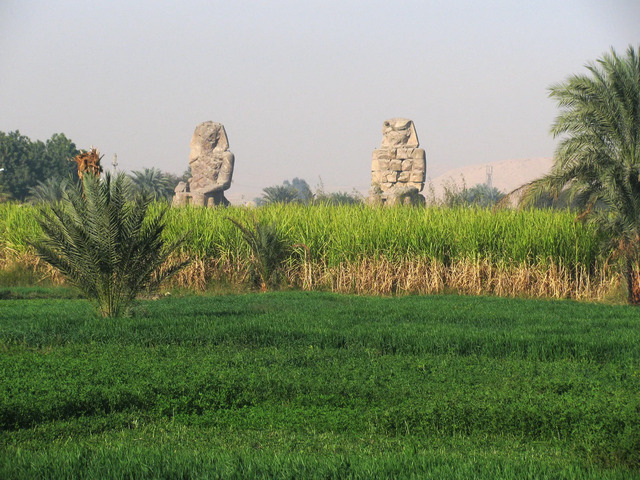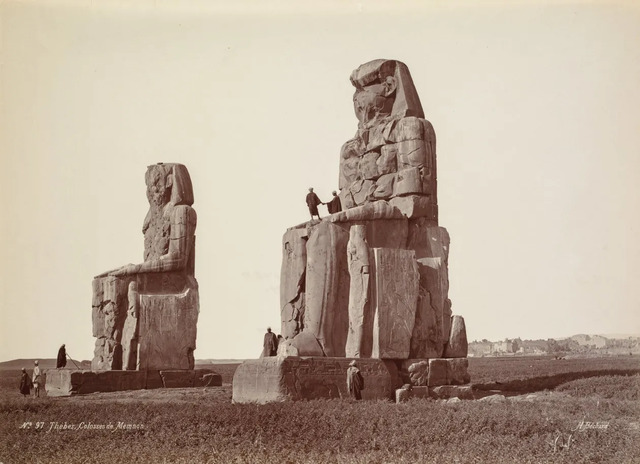The Colossi of Memnon, towering statues of Pharaoh Amenhotep III, stand as silent giants amidst the Egyptian desert, guarding the remnants of a once-glorious temple. These colossal figures, with their ancient history and mythological ties, have captivated travelers and archaeologists alike for centuries. Despite the ravages of time, earthquakes, and human interference, the Colossi continue to awe with their sheer scale and resilience, offering a glimpse into the grandeur of ancient Egypt.
The History Behind the Colossi
The Colossi of Memnon were built during the reign of Pharaoh Amenhotep III, around 1350 B.C., as part of his grand mortuary temple, a structure dedicated to the king and his afterlife. Amenhotep III, one of Egypt’s most prosperous pharaohs, wanted to ensure that his legacy would endure for centuries. The two statues, each towering at about 60 feet (18 meters), were placed at the entrance of his temple to guard it. Made from quartzite, they weigh an estimated 720 tons per statue, a sheer display of the ancient Egyptians’ engineering prowess.
Initially, the Colossi were part of a vast temple complex, which, at the time, was the largest and most sumptuous in all of Ancient Egypt. It dwarfed later temples, including the Ramesseum of Ramesses II and the Medinet Habu of Ramesses III. Sadly, with the passing of time, the temple itself has nearly vanished, with the Colossi standing as the sole remnants of its grandeur.

Video
Watch this video to explore the massive Egyptian stone statues, the Colossi of Memnon, and uncover their mysteries as part of the Lost Ancient Civilizations series.
Mythology and Misinterpretation
Although the statues were meant to honor Amenhotep III, they became mistakenly associated with the Greek mythological figure Memnon. Ancient Greek travelers, particularly those from the Roman Empire, believed the northern statue depicted Memnon, the son of the goddess Eos. This belief arose because of the “singing” or “moaning” sounds the statue allegedly made at dawn, a phenomenon caused by the vibrations from the air temperature change that affected the statue’s cracked surface. As a result, the Colossi became known as the “Colossi of Memnon.”
The inscriptions found on the statues, dating from the Roman period (around 20 to 250 A.D.), refer to this mythological connection, with some even mentioning the name of Memnon. These inscriptions, written in Greek and Latin, further cemented the idea that the statues were linked to the legend, despite their true identity as representations of Amenhotep III.
Architectural Features and Design

The Colossi of Memnon are extraordinary in both their size and design. Each statue was originally carved from a single block of quartzite, with one statue being made from a single piece and the other featuring a large crack in its lower half. This crack, caused by an earthquake in 27 B.C., led to a reconstruction effort, with the upper portion of the northern statue being made from sandstone. The statues are notable for their intricate depictions of the pharaoh, surrounded by the figures of his Great Royal Wife Tiye and his mother, Mutemwiya. These figures, though smaller, were placed next to the king’s legs, symbolizing their importance within the royal family.
Hapi, the Nile god, is also represented on the sides of the thrones, emphasizing Amenhotep’s connection to the river that sustained Egypt. The statues’ placement facing eastward, towards the Nile, suggests the king’s connection to the life-giving water, as well as his eternal journey towards the afterlife.
The Temple Complex and Its Demise
Amenhotep III’s mortuary temple was an awe-inspiring structure, intended to honor both the king’s life and death. It was situated on the edge of the Nile floodplain, and its location, while magnificent, was not without its challenges. The river’s annual inundations gnawed away at the temple’s foundations over time, contributing to its gradual erosion. As depicted in an 1840s lithograph by David Roberts, the Colossi stood surrounded by water, a testament to nature’s slow destruction of the temple.
However, nature was not the only factor in the temple’s demise. It was common for subsequent rulers to dismantle and usurp monuments built by their predecessors. The temple complex, once the grandest in Egypt, was ultimately devastated by an earthquake around 1200 B.C. This catastrophic event caused massive damage, leaving only the two Colossi standing as relics of the once-vibrant structure.
Earthquake Impact and Reconstruction

The devastation caused by the 1200 B.C. earthquake was catastrophic. The tremors resulted in large fissures in the ground, burying statues and monuments. Many of the statues were left in pristine condition, only to be lost beneath the earth. However, the Colossi of Memnon remained standing, albeit damaged. The statues would face further destruction when another earthquake struck in 27 B.C., causing even more damage.
Despite the repeated destruction, the Romans later undertook reconstruction efforts to preserve the statues. The northern statue, in particular, received extensive repairs, with the addition of sandstone to the upper portion. This Roman intervention helped ensure the survival of the Colossi, although their original form was altered in the process. The repairs credited to Emperor Septimius Severus are evident in the layers of stone that now make up the northern statue.
The Colossi in Modern Times
Over the centuries, the Colossi of Memnon have survived numerous disasters, including both natural forces and human interventions. The statues became a major attraction for tourists and scholars alike, especially during the 19th century. Early photographers like Maxime Du Camp captured iconic images of the statues, offering the world a glimpse of their monumental scale and the surrounding ruins. The Colossi have continued to stand as symbols of ancient Egypt’s grandeur, even as the majority of Amenhotep III’s temple remains lost to time.
Today, the statues continue to draw visitors from all over the world, who come to witness their magnificence and to learn about the history of one of Egypt’s greatest pharaohs. The Colossi are not just archaeological artifacts; they are also symbols of resilience, having withstood the ravages of time, war, and nature.

The Legacy of the Colossi of Memnon
The Colossi of Memnon stands as an enduring legacy of Amenhotep III’s reign and the architectural prowess of ancient Egypt. Their construction and the stories surrounding them have influenced generations of scholars, archaeologists, and artists. The statues symbolize both the power of the pharaohs and the vulnerability of even the mightiest monuments to the forces of nature.
The Colossi of Memnon have left a lasting imprint on the field of Egyptology, serving as a reminder of the ancient world’s ability to craft monumental works of art and engineering. Their association with the myth of Memnon has also ensured their place in both Egyptian history and Greek mythology, making them a unique blend of cultural significance.
Video
Check out this 4K video to explore the ancient monuments of Egypt, showcasing the timeless wonders and historical marvels that have shaped the country’s legacy.
Conclusion
The Colossi of Memnon remain as one of the most iconic symbols of ancient Egypt. These colossal statues, built to honor Pharaoh Amenhotep III, have weathered centuries of natural disasters, human interference, and the passage of time. Despite the loss of Amenhotep III’s grand mortuary temple, the Colossi continue to stand as monuments to the pharaoh’s legacy, embodying the power, artistry, and enduring mystery of ancient Egypt. The statues not only tell the story of a powerful ruler but also reflect the universal human desire to create something that will last through the ages, defying both time and nature.



